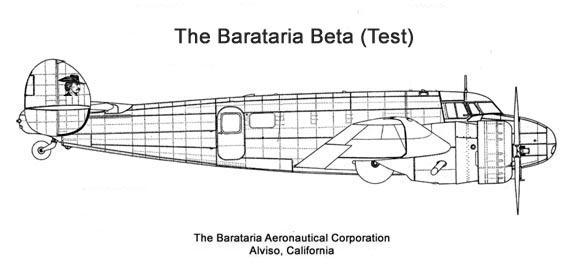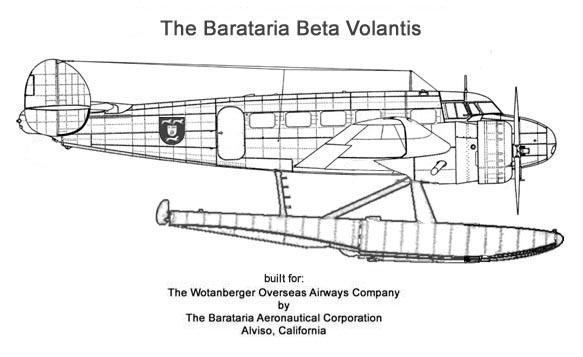Notice: Use of this site constitutes your acceptance of these Terms of Use. Barataria Industries (a proud member of the of the Trans-Global
Enterprises family)
 For a number of years, Barataria had capitalized on its experience with speedboat hull design and construction to carry out special order conversions of aircraft into float planes. Some of these jobs had been done for Barataria's "friend and neighbor" in Alviso, Pan Pacific Airways. In 1934, Pan Pacific contacted Barataria and indicated that if Barataria could produce a passenger plane like the new Lockheed L10Electra or Douglas DC-2, Pan Pacific would buy at least five. With the hefty deposit made by Pan Pacific, Barataria began research and design on what would become a twin-engined aircraft bearing the "family" name Beta.* The "father" of the "family" was the Beta [Test], shown here at an undisclosed location in Nevada being prepared for the return trip to Alviso as part of a special experimental flight in late 1934. 
The most popular member of the "family" was undoubtedly the Beta Pegasi, a passenger craft flown by a number of commercial airlines, including Aero-Carlotta, Barranca Airlines, and, of course, Pan Pacific Airways. A
special version of the Beta Pegasi was
designed and built for the Wotanberger
Overseas
Airways Company (WOAC) named the Beta
Mustelae. (The
Grand Duchy of Wotanberg has given the
name Mustela--the Weasel--to what the
rest of the world calls Ursa Minor.)  This
aircraft disappeared in December of 1938 just
days after this photograph was taken.
(Additional information on this plane, the woman
in the photograph, and their disappearance is
available here .) Another Beta
Mustelae was built for WOAC to replace
the one that disappeared. Other members of the Beta "family" included the following:
____________________________________________ * (1) The Corporation denies that the Battle-ax was merely a cheap copy of the more famous Curtis Tomahawk. Although the Battle-ax was named after a weapon like the Tomahawk, the Corporation notes that there are significant differences between the two aircraft. The Corporation also states that it is merely coincidental that its development of the Battle-ax began shortly after the reported disappearance of a complete set of plans for the Tomahawk. (2) The Corporation also denies that the Battle-axes were part of a covert U.S. government operation to secretly transfer real Tomahawk to various fronts for American and friendly foreign intelligence agencies. It specifically denies that it merely acted as a conduit for these transfers, making only some minor, mostly cosmetic, modifications to Tomahawk prior to "selling" them as Battle-axes. |
